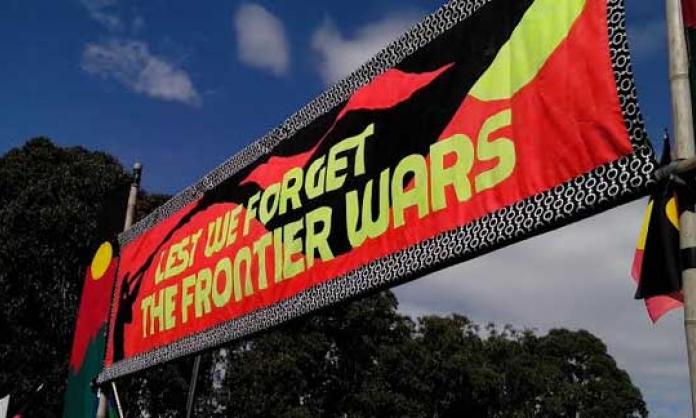For months, the media was saturated with accounts of the Gallipoli landing; TV schedules were filled with documentaries and dramas about the campaign and the lives of the soldiers who were sent to fight.
Politicians and generals took to podiums on ANZAC day, as they do every year, to make speeches about the importance of remembering and how Australia has been defined by its military adventures. Gallipoli “shaped Australia”, says Brendan Nelson, director of the Australian War Memorial and former federal Liberal leader.
Far from the official dignitaries, another history was remembered this year. Forced to the back of Canberra’s ANZAC Day parade, Aboriginal activists and their supporters assembled to remember the wars that are never mentioned from the stage, but which more profoundly shaped Australia.
The Frontier Wars lasted more than 140 years as the First Nations stood against the colonial invasion of their lands. In Queensland, where the wars were the bloodiest, recent studies estimate that 66,680 people perished, more than 65,000 of whom were Aboriginal.
The Australian War Memorial, one of the largest in the world, refuses to recognise the Frontier Wars and contains no mention of the fallen. Entire sections of bookshops are dedicated to Australian military history, but it’s often impossible to find even one history of the Frontier Wars among them. They have been whitewashed.
“If you want to know why we’re here just read these signs.” Ghillar Michael Anderson, who leads the Canberra march, points to placards held by the participants. Each tells some of the history that Australia’s ruling class is so keen for us to forget: “1867, Goulbolba Hill Massacre. 300 Aboriginal people, including all the women and children, shot dead or drowned”; “1838, Myall Creek Massacre. 28 Gumilaroi people killed”; “1790-1816, Hawkesbury and Nepean Wars. Pemulwuy leading the Eora, Dharug and Tharama people. 200 plus killed resisting white settlement”.
The marchers aren’t allowed on the official ANZAC parade, so the plan was to follow behind the last official contingent and lay a wreath at the War Memorial to commemorate those who died in the defence of their lands. As the march starts, onlookers clap and show their support, others take photos of the lead banner: “Lest we forget the Frontier Wars”.
But we have hardly moved 100 metres when the Federal Police block the path, forcing us to stop before we reach the bigger crowds.
Fred Hooper, chairman of the Murrawarri nation and an ex-navy submariner, carries the wreath toward the memorial on his own and is forced back by police. “You’re not part of the authorised march”, they tell him. “They don’t want you here”.
“What law did I break by wanting to march like the people I have served with?”, Fred asks. “Why aren’t I allowed to march?”
The police respond by threatening him with arrest.
Another Aboriginal man appealed to the small crowd of onlookers: “We’re not allowed to remember our people, on our land!”
The police respond: “If you continue in this manner you will be arrested.” He refuses to be silenced and the police try and grab him. More police come over. The march to remember the Frontier Wars is stopped. “We’re only half way up ANZAC Avenue”, Graeme Dunstan, long time political activist and alumnus of the Royal Military College tells me. “There’s a huge crowd ahead of us and they won’t let us go near them.”
Despite all the talk of remembering the past and honouring the dead, the RSL and the War Memorial have no interest in the Frontier Wars. It’s too clearly a reminder of the theft of land and the massacres, the destruction of Aboriginal society and culture. Those were the events that really shaped Australia.
The stopping of the march is also a reminder that the war on Aboriginal people is still being waged.








